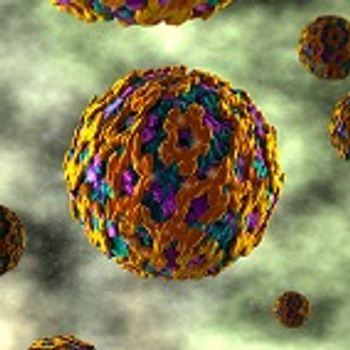
Management of visceral leishmaniasis poses a daunting challenge, in part due to the side effects associated with the use of the traditional treatment. However, one vaccine development strategy has recently shown promising results.


Management of visceral leishmaniasis poses a daunting challenge, in part due to the side effects associated with the use of the traditional treatment. However, one vaccine development strategy has recently shown promising results.

The number of expecting mothers who opt for annual vaccination for influenza during pregnancy remains relatively low; however, the results of a new study suggest this may be changing—and that there are obvious benefits for immunization for newborns.

Christina G. Tan, MD, MPH, FACP, New Jersey State Epidemiologist/Assistant Commissioner, outlines New Jersey Department of Health’s role in vaccine awareness.

Healthcare-associated infections (HAIs) can have dramatic effects on excess morbidity and associated costs and so finding effective and efficient way to prevent them is important.

Researchers from the department of pathology at the Beth Israel Deaconess Medical Center in Boston developed and validated a high-throughput screen (HTS) that could detect antimicrobial agents with the ability to restore carbapenem susceptibility to resistant strains, as well as those that target CRE directly.

In an address to the 69th annual World Health Assembly, Margaret Chan, MD, MPH, director-general of the World Health Organization (WHO), discussed the impending threat of yellow fever.

Cutting-edge technologies help public health professionals detect and respond to infectious disease outbreaks more rapidly and effectively than traditional methods. The Centers for Disease Control and Prevention’s Epidemic Intelligence Service (EIS) officers presented a few of their resources to their colleagues in a special session on May 3, Using Advanced Molecular Tools to Direct Public Health Action, at the 65th Annual EIS Conference in Atlanta, Georgia.

Researchers at the University of Texas Medical Branch (UTMB) at Galveston have successfully cloned the Zika virus strain.

“An outbreak anywhere is a risk everywhere,” according to the Centers for Disease Control and Prevention (CDC). Officers of the CDC’s Epidemic Intelligence Service (EIS) are studying several emerging infections – those that have recently increased or show signs of increasing soon – and five researchers presented their results May 4 in the Emerging Infections session of the 65th Annual Epidemic Intelligence Service (EIS) Conference in Atlanta, Georgia.

Christina G. Tan, MD, MPH, FACP, New Jersey State Epidemiologist/Assistant Commissioner, explains how health care practitioners can aid in the prevention of Zika virus infections.

The US government must allocate additional resources toward global research and development (R&D) efforts working toward solutions for historically “neglected” diseases such as malaria, tuberculosis, and HIV/AIDS in order to meet the challenges posed by them, a new report has concluded.

Christina G. Tan, MD, MPH, FACP, New Jersey State Epidemiologist/Assistant Commissioner, discusses Zika vector prevalence and infection prevention in New Jersey

The Centers for Disease Control and Prevention (CDC) recently announced that it has expanded the use of a disease identification tool to help speed disease recognition in laboratories.

On May 16, 2016, the Australian Olympic Committee (AOC) announced that the country’s Olympic team members will receive Dual Protect VivaGel condoms, the world’s only antiviral condom, for the 2016 Olympic Games in Rio de Janeiro.

In early April the World Health Organization (WHO) announced that most provinces in Angola have experienced a yellow fever outbreak. Now, scientists are calling this the country’s worst epidemic since 1986, urging WHO to take action.

For patients who suffer from certain uncomplicated infections such as, sinusitis, bronchitis, and uncomplicated urinary tract infections, the health risks associated with fluoroquinolone far outweigh the benefits.

It has been more than 50 years since an epidemic resulted in as many birth defects as the Zika virus. To address this epidemic, the second in a series of six teleconferences, hosted by the Centers for Disease Control and Prevention (CDC), discussed Zika infection during pregnancy as well as subsequent birth defects.

Congress is in the midst of approving a bill that may grant over $1 billion in funds to combat the active transmission of the Zika virus in the United States.

Evidence from a clinical trial has shown that a new vaccine protects adults against malaria infection for at least 14 months.

Older antibiotic agents show decreased potency due to overuse and the subsequent emergence of drug-resistant bacteria. This antimicrobial resistance has been predicted to have enormous consequences for human health, necessitating the development of new agents in the ongoing war between humans and the germs that attack us.

To inform Puerto Rico residents of the threat of the Zika virus, the National Association of Chain Drug Stores (NACDS) Foundation has launched a digital Zika education campaign.

Officials are stating that although the first case of locally-acquired Zika virus in the United States may be weeks or months away, the time to prepare is now.

Antibiotic-resistant pathogens continue to make the management of some bacterial infections a significant clinical challenge.

In an effort to aid in the prevention of food-borne infections, the USDA created a mobile app that provides users with “valuable storage advice” to help maximize shelf-life, prolong freshness, and improve the quality of foods and beverages.

Rohit Bhalla, DO, Chief of the Section of Infectious Diseases at the University Medical Center of Princeton, discusses if we will see more vaccine-preventable diseases in the United States in the future.